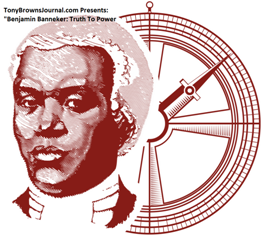 Imagine being Black in the 1700s and becoming a self-taught surveyor who played a pivotal role in planning the layout of our nation’s capital. In 1753, at the age of 22, Banneker constructed a striking wooden clock without having ever seen a clock before (although he had examined a pocket watch). He painstakingly carved the toothed wheels and gears of the clock out of seasoned wood. The clock operated successfully until the time of his death.
Imagine being Black in the 1700s and becoming a self-taught surveyor who played a pivotal role in planning the layout of our nation’s capital. In 1753, at the age of 22, Banneker constructed a striking wooden clock without having ever seen a clock before (although he had examined a pocket watch). He painstakingly carved the toothed wheels and gears of the clock out of seasoned wood. The clock operated successfully until the time of his death.
In 1791 alone, Benjamin Banneker completed the survey of Washington, DC, published his first almanac and confronted one of the nation’s founders, Thomas Jefferson, about his doctrine of Black inferiority.
A free Black man who owned a farm near Baltimore, Benjamin Banneker was largely self-educated in astronomy and mathematics. He was later called upon to assist in the surveying of the territory for the construction of the nation's capital. As a self-empowered person, he also became an active writer of almanacs and exchanged letters with Thomas Jefferson, politely challenging him to do what he could to ensure racial equality.
Banneker's accomplishments extended into other realms as well, including civil rights. In 1791, Jefferson was Secretary of State and Banneker, considered the respected Virginian, though a slaveholder, to also be open to view African Americans as human sentients. Thus, he wrote Jefferson a letter hoping that he would “readily embrace every opportunity to eradicate that train of absurd and false ideas and opinions which so generally prevail with respect to us." To further support his point, Banneker included a handwritten manuscript of an almanac for 1792, containing his astronomical calculations.
My guest on this program, Charles A. Cerami, former editor of the Kiplinger Washington Publications and author of Benjamin Banneker, explains that there was a lot more to Banneker than what is written in the history books.
FEATURED THIS WEEK ON TonyBrownsJournal.com
TBJ #2515 Benjamin Banneker: Truth to Power. Imagine being Black in the 1700s and becoming a self-taught surveyor who played a pivotal role in planning the layout of our nation’s capital and inventing a clock in 1753. In 1791 alone, Benjamin Banneker completed the survey of Washington, DC, published his first almanac and confronted one of the nation’s founders, Thomas Jefferson, about his doctrine of Black inferiority.






